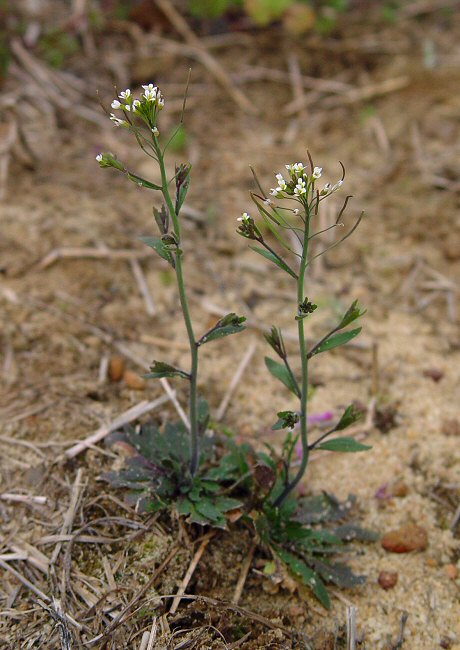Arabidopsis thaliana (L.) Heynh.
Mouse-Ear Cress

Introduced
CC = *
CW = 5
MOC = 32
© DETenaglia
Arabidopsis thaliana (L.) Heynh.Mouse-Ear Cress | |
 |
Introduced CC = * CW = 5 MOC = 32 |
© DETenaglia |
|
Family - Brassicaceae Habit - Taprooted annual forb. Stems - Ascending to erect, to 50 cm, branched or unbranched, single or multiple from the base, apically glabrous, basally pubescent with branched and unbranched hairs.
Leaves - Basal and alternate. Basal leaves in a rosette, spatulate, petiolate, entire or shallowly dentate, to 6 cm long, with branched hairs, rounded at the apex. Stem leaves to 3 cm, sessile, not clasping stem, simple, entire, ciliate-margined, surfaces with some branched hairs, elliptic, rounded at the apex, relatively few (2-6) per stem.
Inflorescence - Terminal and axillary racemes, compact in flower, elongated in fruit to 15 cm. Pedicels to 1 cm long in fruit, glabrous, glaucous.
Flowers - Sepals 4, 1.0-2.0 mm long, ascending, oblong, hairy. Petals 4, white, glabrous, spatulate, to 4 mm long, rounded at the apex. Stamens 6, erect. Filaments white, glabrous, 2.5 mm long. Anthers yellow, 0.3 mm long. Ovary cylindric, green, glabrous, superior, 2 mm long in fruit. Style to 0.5 mm.
Fruits - Siliques spreading to ascending, nearly straight, to 1.8 cm long, to 20 times as long as wide, terete, glabrous, many-seeded, beaked, each valve with a midnerve. Seeds in 1 row in each locule, 0.3-0.5 mm long, oblong in outline, the surface with a fine, netlike or honeycomblike pattern of ridges and pits to nearly smooth, orange.
Flowering - April - May. Habitat - Open sandy ground, rocky open ground, fallow fields, pastures, roadsides, railroads. Origin - Native to Europe. Lookalikes - Small species of Cardamine, e.g. C. parviflora and C. hirsuta. Other info. - This small and inconspicuous species can be found mostly in the southern half of Missouri. It is also found in scattered locations throughout the U.S., predominantly in the Northeast and along the west coast. The plant is fairly wispy and indistinct but can be identified by its thin siliques, small white flowers, basal rosette with branched hairs, and hairy (near the base) stems. A. thaliana is used widely in experiments on plants due to its small size, short life cycle, and relatively simple genome. Photographs taken in Brown Summit, NC., 3-13-03, and 4-6-03, and in Auburn, AL., 2-19-05 (DETenaglia); also near Labadie, Franklin County, MO, 4-8-2016, Pacific Palisades Conservation Area, Jefferson County, MO, 4-2-2019, and Amidon Conservation Area, Madison County, MO, 3-26-2020 (SRTurner). |